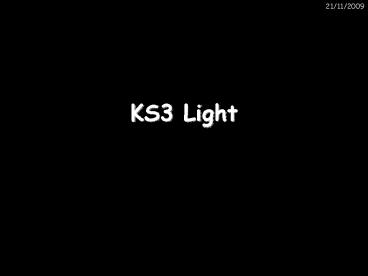KS3 Light - PowerPoint PPT Presentation
1 / 30
Title:
KS3 Light
Description:
Light travels VERY FAST around 300,000 kilometres per second. ... 2) When a starting pistol is fired we see the smoke first and then hear the bang. ... – PowerPoint PPT presentation
Number of Views:605
Avg rating:3.0/5.0
Title: KS3 Light
1
KS3 Light
Miss Scale Greenhill School
2
Properties of Light
- Light travels in straight lines
3
- Light travels VERY FAST around 300,000
kilometres per second.
At this speed it can go around the world 8 times
in one second.
4
- Light travels much faster than sound. For example
- Thunder and lightning start at the same time, but
we will see the lightning first.
- 2) When a starting pistol is fired we see the
smoke first and then hear the bang.
5
- We see things because they reflect light into our
eyes
Homework
6
- Luminous and non-luminous objects
A luminous object is one that produces light. A
non-luminous object is one that reflects light.
Luminous objects
Reflectors
7
- Shadows
Shadows are places where light is blocked
8
Properties of Light summary
- Light travels in straight lines
- Light travels much faster than sound
- We see things because they reflect light into our
eyes - Shadows are formed when light is blocked by an
object
9
Reflection
- Reflection from a mirror
Normal
Reflected ray
Incident ray
Angle of reflection
Angle of incidence
Mirror
10
- The Law of Reflection
Angle of incidence Angle of reflection
In other words, light gets reflected from a
surface at ____ _____ angle it hits it.
The same !!!
11
Clear vs. Diffuse Reflection
- Smooth, shiny surfaces have a clear reflection
Rough, dull surfaces have a diffuse
reflection. Diffuse reflection is when light is
scattered in different directions
12
Using mirrors
- Two examples
2) A car headlight
1) A periscope
13
Colour
- White light is not a single colour it is made up
of a mixture of the seven colours of the rainbow.
We can demonstrate this by splitting white light
with a prism This is how rainbows are formed
sunlight is split up by raindrops.
14
The colours of the rainbow
- Red
- Orange
- Yellow
- Green
- Blue
- Indigo
- Violet
15
Red
Magenta
Yellow
White
Blue
Green
Cyan
16
Adding colours
- White light can be split up to make separate
colours. These colours can be added together
again. - The primary colours of light are red, blue and
green
Adding blue and red makes magenta (purple)
Adding blue and green makes cyan (light blue)
Adding all three makes white again
Adding red and green makes yellow
17
Seeing colour
- The colour an object appears depends on the
colours of light it reflects.
For example, a red book only reflects red light
White light
Only red light is reflected
18
A pair of purple trousers would reflect purple
light (and red and blue, as purple is made up
of red and blue)
Purple light
A white hat would reflect all seven colours
White light
19
Using coloured light
- If we look at a coloured object in coloured light
we see something different. For example,
consider a football kit
Shirt looks red
White light
Shorts look blue
20
- In different colours of light this kit would look
different
Red light
Shirt looks red
Shorts look black
Shirt looks black
Blue light
Shorts look blue
21
Some further examples
22
Using filters
- Filters can be used to block out different
colours of light
23
Investigating filters
24
Red
White
Blue
Green
Magenta
Yellow
Cyan
25
Refraction
- Refraction is Bending Light
- When light travels from one substance to
another, the speed it travels changes - The change in speed means it can BEND
26
Refraction through a glass block
Wave slows down but is not bent, due to entering
along the normal
27
(No Transcript)
28
Refraction
Refraction is when waves ____ __ or slow down due
to travelling in a different _________. A medium
is something that waves will travel through.
When a pen is placed in water it looks like
this In this case the light rays are slowed
down by the water and are _____, causing the pen
to look odd. The two mediums in this example are
______ and _______.
Words speed up, water, air, bent, medium
29
The Eye
30
The Parts of the Eye
- IRIS Coloured part, controls size of pupil
- PUPIL Opening that controls the amount of light
into the eye - CORNEA Transparent layer over the eye
- LENS Focuses light coming into the eye
- RETINA Area at the back of the eye where the
image is projected - OPTIC NERVE Sends the signal to the brain































